#ishiyama kannon
Photo

Two stone relief images of Jizō Bodhisattva (地蔵菩薩), one standing, one seated, down in a little river gully a bit off the beaten path at Ishiyama Kannon (石山観音) in the outskirts of Tsu, Mie Prefecture
Image from the city’s official website
101 notes
·
View notes
Text
Sun Wukong Part 1 (1956) 孫悟空 第一部
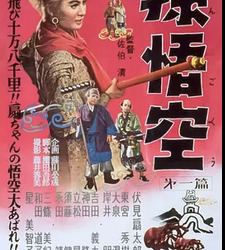
Director: Kiyoshi Saeki
Starring: Fushimi Sentaro / Tonomiya Hideki / Oizumi Akira / Yoshida Yoshio
Country/Region of Manufacture: Japan
Language: Japanese
Date: 1956-11-28 (Japan)
Duration: 61
Type: Retelling
Summary:
Part 1--Once upon a time, long ago. In China, a lone stone monkey came out of a giant rock on Mt. Huaguo. This stone monkey, who is familiar with the art of 72 ways of change, calls himself Great Sage Son Goku, and with a staff in his hand, he rides the somersault cloud which can fly 188,000 li at a time, and commits evil deeds. Do your best. Seeing this, The Josei Gyokuten in the heavenly palace made Goku a peach of perpetual youth and the keeper of Peach Gardens, but on the day of the banquet of the gods Peach Party, he devoured the guests' feast. Finally, he was imprisoned in the hands of Shaka Nyorai and imprisoned in Ishiyama Gogyoyama, where the hands turned into.
Five hundred years later, Kannon Bodhisattva of Nankai, who heard a voice asking for Goku's salvation, and Totsuchi Great Tang Province, who sees that there is a color of repentance and goes to Tenjiku to retrieve the sutra, forgives the sin on the condition of Sanzo Hoshi's accompaniment. Soon after, Goku takes control of the white horse that Sanzo is riding and departs.
He was looking for an inn in a certain village, but was told that there was a monster there. The man named Ino, who was adopted by the village chief Kouta as his son-in-law, is the person in question. Goku uses his special technique of transformation to finally subdue this pig monster. He was originally a resident of the heavenly world, but by order of Kannon, he was given the name Hakkai and joined one of his companions.
On the way to hurry on the journey, the flow of sand called Ryusha River. The kappa monster appears again and confronts Goku and Hakkai. However, with the news of Egishi Sonja, this monster Sagojyo also joined them, and the party of four people gathered together. Back in Kitayama, there were lights of houses on the way. Sanzo Hoshi, who went to beg for food, becomes a decoy for the seven bewitching beauties.
Source: https://movie.douban.com/subject/24383414/
Link: N/A
#Sun Wukong Part 1#孫悟空 第一部#jttw media#jttw movie#movie#lost media#live action#Retelling#Sun wukong#zhu bajie#sha wujing#Tang Sanzang#monk tripitaka#rewrite
7 notes
·
View notes
Text
The Major Captain found her reaction hard to take, but he was also moved and overjoyed at the realization that their karmic bond had not been a tenuous one after all. His chest would tighten at the very thought that such a face and figure as hers, which seemed more resplendent each time he saw her, had been on the verge of belonging to someone else, and he felt that he should give thanks to both the Kannon at Ishiyama Temple and his go-between, Ben no moto, for answering his prayers.
— Murasaki Shikibu, The Tale of Genji
1 note
·
View note
Photo

A pamphlet from Ishiyama Kannon (石山観音) in the outskirts of Tsu, Mie Prefecture, featuring one of the park area’s many historic stone images of Kannon Bodhisattva (観音菩薩)
Acquired at the park February 24, 1996
#三重県#mie prefecture#津市#tsu#石山観音公園#石山観音#ishiyama kannon#buddhist art#観音菩薩#観音#kannon#avalokitesvara#pamphlet#ephemera#printed ephemera#paper ephemera#crazyfoxarchives
15 notes
·
View notes
Photo

A stone relief image of Nyoirin Kannon Bodhisattva (如意輪観音菩薩) dating to the Edo period (1600-1868) at Ishiyama Kannon (石山観音) in the outskirts of Tsu, Mie Prefecture
Photo by 打田しのぶ [Uchida Shinobu] December 2022
#buddhist art#如意輪観音菩薩#如意輪観音#nyoirin kannon#観音菩薩#観音#kannon#avalokitesvara#三重県#mie prefecture#津市#tsu#石山観音公園#石山観音#ishiyama kannon
15 notes
·
View notes
Text
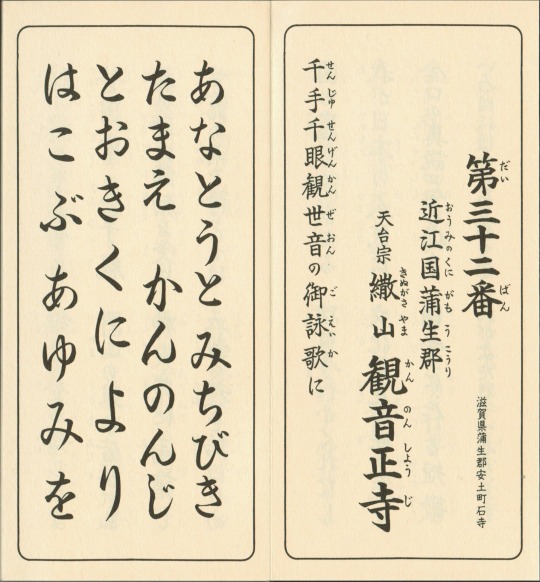
The pilgrims’ hymn for Kannonshōji Temple (観音正寺) in Ōmihachiman, Shiga Prefecture, from a hymnal for the thirty-three temples of the western pilgrimage circuit dedicated to Kannon Bodhisattva (観音菩薩)
My own rough, tentative translation follows:
Number Thirty-Two: Mount Kinugasa Kannonshōji Temple (Tendai School) in Gamou District, Ōmi Province
Ishiyama, Azuchi Town, Gamou County, Shiga Prefecture
A hymn for Thousand-Armed Thousand-Eyed Kannon:
Most holy Kannon,
Kindly guide us on our way
To your temple true,
As we have journeyed so long
From lands very far away
Image from “Saigoku Sanjūsansho Goeika” (西国三十三所 御詠歌) edited by Tomita Haruyuki (冨田晴行), published by Ryūshōdō (隆昌堂) in Osaka, 1995 reprint of the 1973 edition, unpaginated accordion book
#buddhist temple#滋賀県#shiga prefecture#近江八幡市#omihachiman#観音正寺#kannonshoji#西国三十三所#千手観音菩薩#千手観音#senju kannon#観音菩薩#観音#kannon#avalokitesvara#japanese literature#buddhist literature#御詠歌#goeika#japanese music#sacred music#天台宗#tendai#crazyfoxarchives
13 notes
·
View notes
Photo


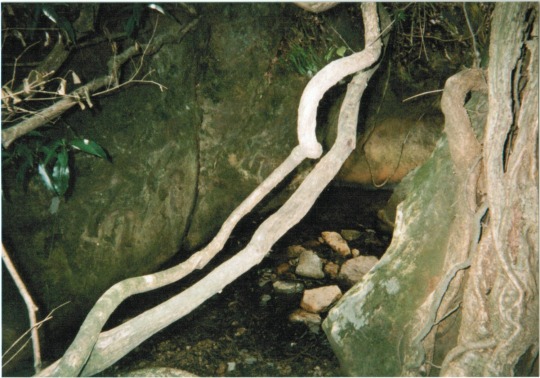
Two stone relief sculptures of Jizō Bodhisattva (地蔵菩薩)--one standing, one seated--along with carvings of his Sanskrit syllable down in a little river gully a bit off the beaten path at Ishiyama Kannon (石山観音) in the outskirts of Tsu, Mie Prefecture
(Photos taken February 24, 1996)
5 notes
·
View notes
Photo

Small stone statue of Fudō Myōō (不動明王) dedicated for the sake of a tranquil world and bountiful harvests at Ishiyama Kannon (石山観音) in the outskirts of Tsu, Mie Prefecture
(Photo taken February 24, 1996)
4 notes
·
View notes
Photo

Stone relief sculpture of Nyoirin Kannon Bodhisattva (如意輪観音菩薩) dating to the Edo period (1600-1868)--probably modeled on that of one of the temples in the Thirty-three Temple Western Pilgrimage Circuit (西国三十三所)--at Ishiyama Kannon (石山観音) in the outskirts of Tsu, Mie Prefecture
(Photo taken February 24, 1996)
#三重県#mie#mie prefecture#津市#tsu#石仏#観音菩薩#観音#kannon#如意輪観音菩薩#如意輪観音#nyoirin kannon#石山観音公園#ishiyama kannon#crazyfoxarchives
5 notes
·
View notes
Photo

Stone relief sculpture of Kannon Bodhisattva (観音菩薩) dating to the Edo period (1600-1868)--probably modeled on that of one of the temples in the Thirty-three Temple Western Pilgrimage Circuit (西国三十三所)--at Ishiyama Kannon (石山観音) in the outskirts of Tsu, Mie Prefecture
(Photo taken February 24, 1996)
3 notes
·
View notes
Photo


Stone relief sculpture of Jizō Bodhisattva (地蔵菩薩) dating to the Muromachi period (1336-1573) at Ishiyama Kannon (石山観音) in the outskirts of Tsu, Mie Prefecture
(Photos taken February 24, 1996)
4 notes
·
View notes
Photo

Stone relief sculpture of Amida Buddha (阿弥陀如来) dating to the Kamakura period (1185-1333), the largest and probably oldest Buddhist image at Ishiyama Kannon (石山観音) in the outskirts of Tsu, Mie Prefecture
(Photo taken February 24, 1996)
3 notes
·
View notes
Photo

Smaller and probably relatively newer stone statue of Thousand-Armed Kannon Bodhisattva (千手観音菩薩) at Ishiyama Kannon (石山観音) in the outskirts of Tsu, Mie Prefecture
(Photo taken February 24, 1996)
#三重県#mie#mie prefecture#津市#tsu#石仏#観音菩薩#観音#kannon#千手観音菩薩#千手観音#senju kannon#石山観音公園#ishiyama kannon#crazyfoxarchives
4 notes
·
View notes
Photo

Stone relief sculpture of Thousand-Armed Kannon Bodhisattva (千手観音菩薩) dating to the Edo period (1600-1868)--modeled on that of the sixth temple in the Thirty-three Temple Western Pilgrimage Circuit (西国三十三所)--at Ishiyama Kannon (石山観音) in the outskirts of Tsu, Mie Prefecture
(Photo taken February 24, 1996)
#三重県#mie#mie prefecture#津市#tsu#石仏#観音菩薩#観音#kannon#千手観音菩薩#千手観音#senju kannon#石山観音公園#ishiyama kannon#crazyfoxarchives
3 notes
·
View notes
Photo

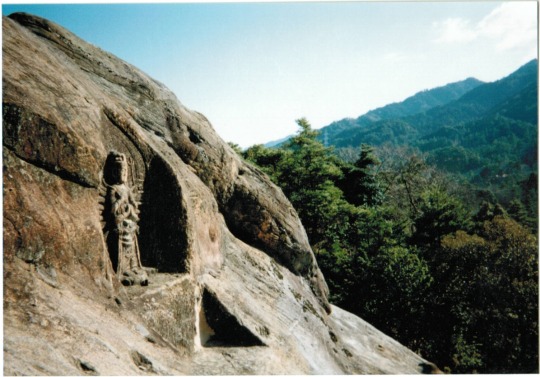
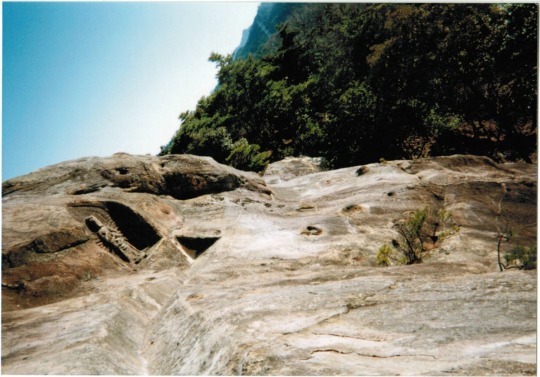
Stone relief sculpture of Thousand-Armed Kannon Bodhisattva (千手観音菩薩) at the end of a narrow walkway carved into a steep cliff dating to the Edo period (1600-1868) at Ishiyama Kannon (石山観音) in the outskirts of Tsu, Mie Prefecture
(Photos taken February 24, 1996)
#三重県#mie#mie prefecture#津市#tsu#石仏#観音菩薩#観音#kannon#千手観音菩薩#千手観音#senju kannon#石山観音公園#ishiyama kannon#crazyfoxarchives
4 notes
·
View notes
Photo

A small stone statue of the Shingon founder Kūkai (空海) a.k.a. Kōbō Daishi (弘法大師) at Ishiyama Kannon (石山観音) in the outskirts of Tsu, Mie Prefecture
(Photo taken February 24, 1996)
5 notes
·
View notes